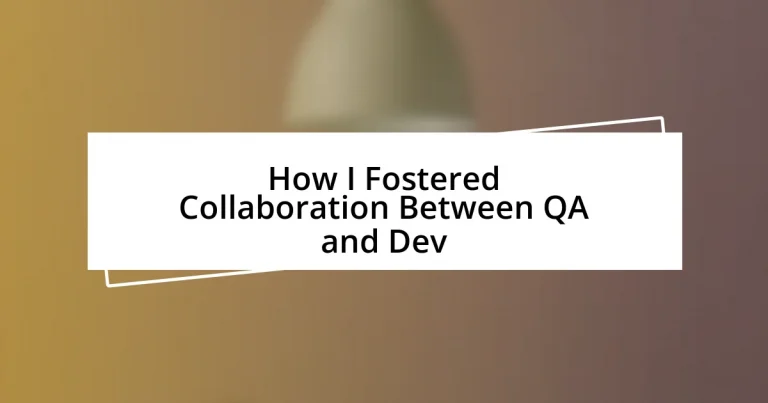Key takeaways:
- Identifying common goals between QA and Dev fostered a sense of unity and motivated collaboration to enhance product quality.
- Establishing effective communication channels, such as regular check-ins and shared documentation, transformed misunderstandings into a transparent and engaging dialogue.
- Implementing joint planning sessions and encouraging cross-functional activities significantly improved mutual respect, understanding, and team morale, leading to successful collaboration.
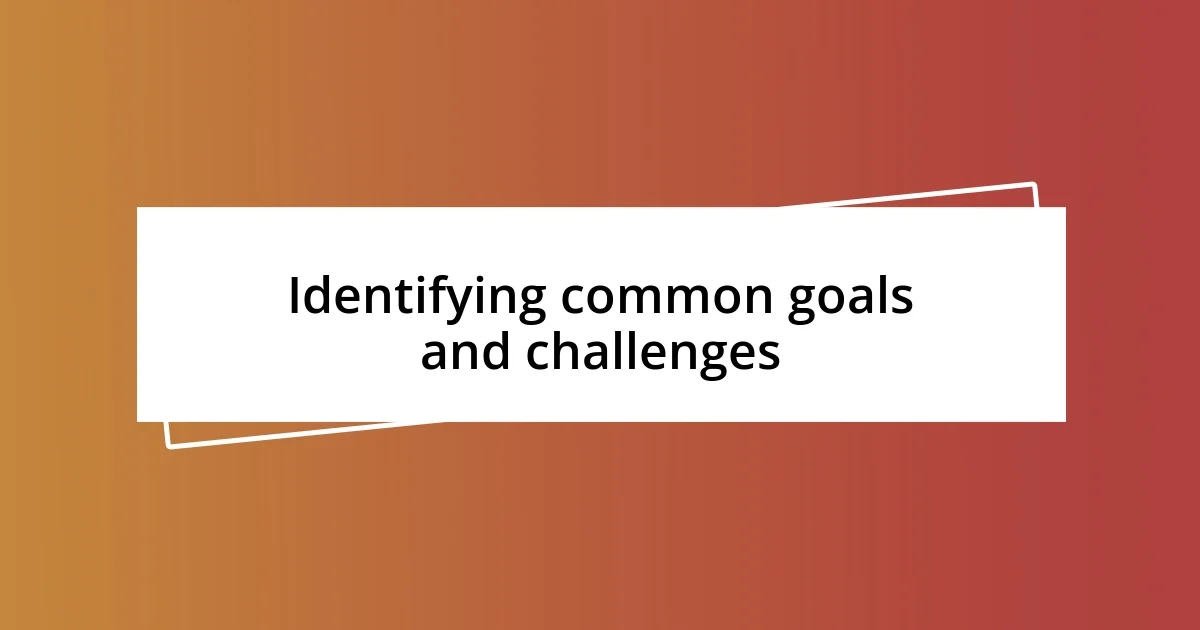
Identifying common goals and challenges
When I began to foster collaboration between QA and Dev, one of the first steps was identifying our common goals. It struck me how both teams aimed for the same outcome: delivering a high-quality product to the users. Realizing this shared vision helped bridge the gap, creating an immediate sense of unity that motivated both sides to work together.
However, it wasn’t all sunshine and rainbows. We also faced significant challenges, like differing priorities and limited communication. I vividly recall a team meeting where a developer expressed frustration over constant bug reports from QA. It highlighted how we needed to shift our perspective, understanding that finding bugs was not a fault, but rather a sign of thorough testing aimed at improving the final product. This realization turned those challenges into a catalyst for deeper dialogue between the teams.
In my experience, asking the right questions played a crucial role in this process. What does success look like for both QA and Dev? How can we support each other in overcoming roadblocks? These questions not only opened up discussions but also led to actionable strategies that focused on our collective growth. Engaging in this reflective practice cultivated an environment where common goals began to overshadow individual challenges, steering us towards collaboration.
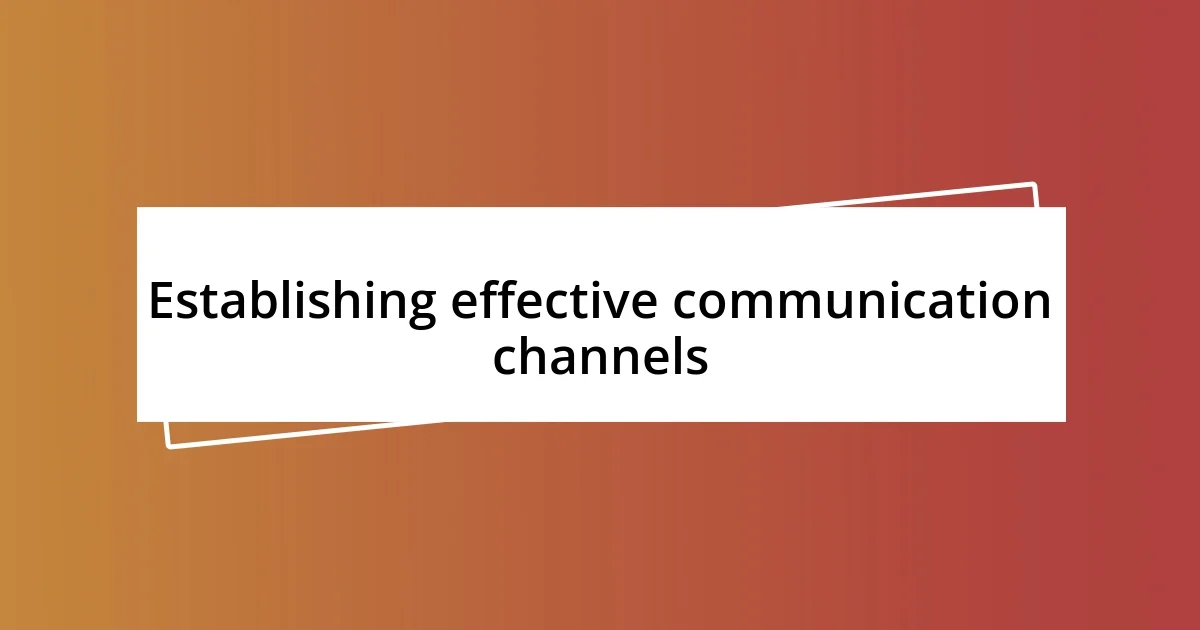
Establishing effective communication channels
Establishing effective communication channels between QA and Dev was like unearthing hidden treasures. Initially, we relied on sporadic emails and brief meetings, which often led to misunderstandings and frustration. I recall one instance when a developer misinterpreted a bug report as a personal attack, which drove a wedge between the teams. That moment made it clear that we needed more structured communication. Creating regular check-ins and shared digital platforms transformed our conversations. These adjustments allowed for real-time updates and feedback, leading to a more transparent and collaborative atmosphere.
To solidify these communication channels, we developed several key practices, including:
- Daily Stand-Ups: A quick forum for both teams to share updates, raise questions, and align priorities.
- Dedicated Communication Tools: Utilizing platforms like Slack to create channels specifically for QA and Dev discussions promoted immediate engagement.
- Shared Documentation: Maintaining a central repository for bug reports and feature requests made information accessible to everyone involved, ensuring no one was left in the dark.
- Feedback Loops: Instituting a structure for ongoing feedback allowed us to refine our processes continuously, fostering a culture of improvement.
- Celebrating Wins: Regularly sharing successes within joint meetings reinforced the positive outcomes of our collaboration, creating an uplifting atmosphere.
By adopting these practices, we transformed our communication landscape, enabling both teams to collaborate more effectively and feel genuinely invested in our shared success.
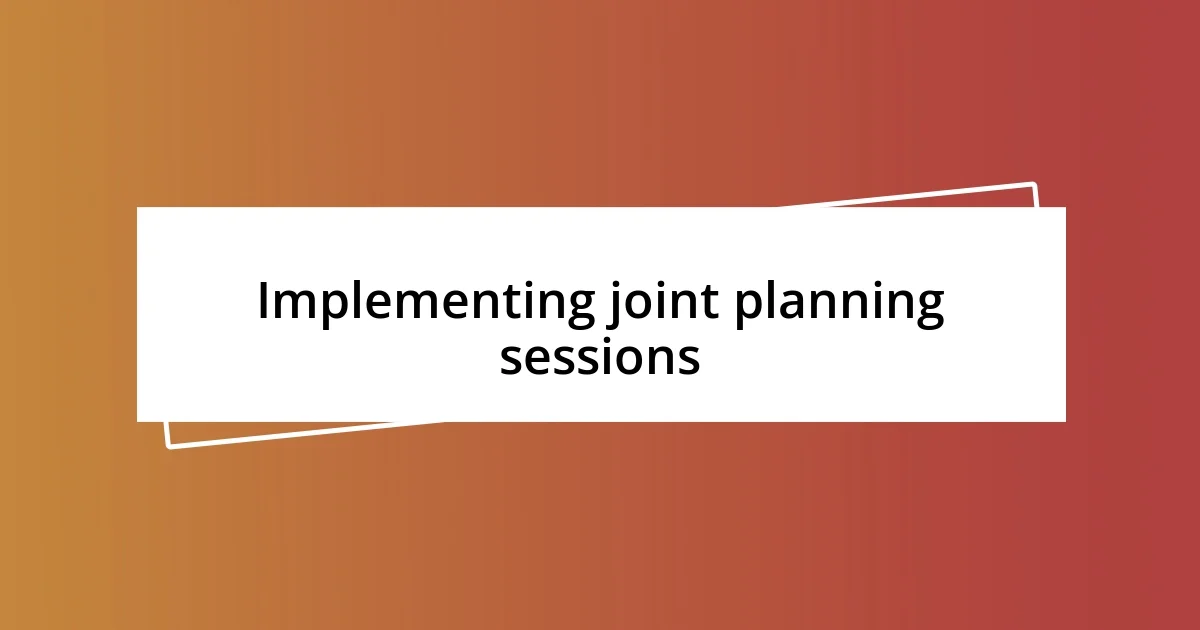
Implementing joint planning sessions
Implementing joint planning sessions was a game-changer for fostering collaboration between QA and Dev. When I first suggested these sessions, I worried about how receptive the teams would be. To my surprise, the initial meeting felt electrifying—everyone was engaged, sharing their thoughts on project timelines and expectations. I remember the instant connection when a QA lead echoed a developer’s concerns about user experiences. It was in that moment I realized we weren’t just teams; we were partners in the journey of creating a product.
These sessions also served as a platform to address potential bottlenecks early in the process. For instance, during one session, a senior developer shared a looming deadline that conflicted with the QA testing schedule. This candid conversation allowed us to reallocate resources in real-time, safeguarding our product quality without compromising on delivery timelines. It was invigorating to witness how openly discussing our plans cultivated mutual respect and understanding between the teams.
Moreover, making these sessions a routine practice bridged gaps I didn’t even know existed. I’ll never forget the lively discussions we had about features that could either be enhanced or revised. When the teams started to share their perspectives freely, the dialogue shifted from “us vs. them” to “how can we make this better together?” This unified approach was not only productive but deeply fulfilling. I felt a sense of pride watching my colleagues find solutions that celebrated everyone’s contributions.
| Aspect | Impact on Collaboration |
|---|---|
| Joint Planning Sessions | Created a unified vision and transparency |
| Open Dialogue | Encouraged respect and mutual understanding |
| Proactive Issue Resolution | Enabled real-time adjustments and better resource allocation |
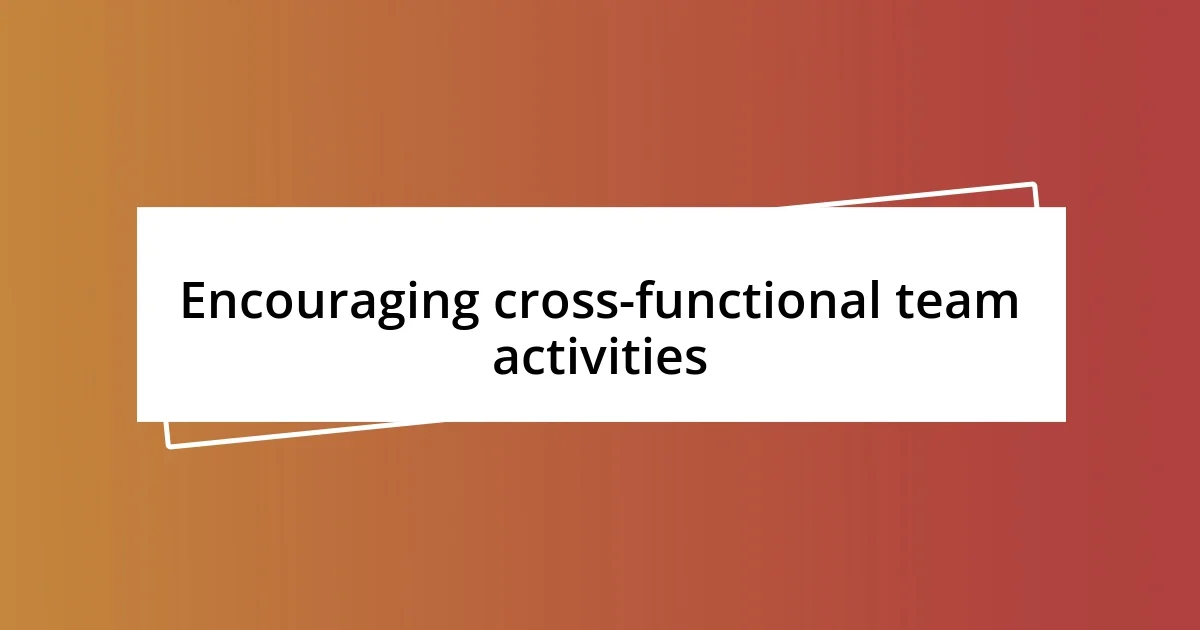
Encouraging cross-functional team activities
Encouraging cross-functional team activities brought a whole new dimension to our collaboration. I decided to organize team-building exercises that brought together QA and Dev in a fun environment outside of our usual workspace. I vividly remember the team scavenger hunt we arranged—everyone was racing around, searching for clues. The laughter and the shared challenges broke down walls. I could see my colleagues from both departments sparking conversations that would’ve never happened in the office. It was a lightbulb moment for me; when teams play together, they start to think together.
In addition, I implemented monthly lunch-and-learn sessions where team members presented topics of interest. These gatherings felt like an unfolding dialogue, where we could appreciate each other’s expertise while nibbling on sandwiches. I once shared my approach to testing techniques, and the curiosity from the developers was palpable. Their questions flowed freely, and I found myself excited to delve deeper into discussions about improving our processes. Reflecting on these moments, it became apparent how knowledge-sharing not only enhanced our skills but also fortified our camaraderie.
I also explored creative collaborations on smaller projects that required input from both teams, and this was an eye-opener. During one project, I deliberately paired a QA analyst and a developer to tackle a feature development together. The synergy that emerged was fascinating; they bounced ideas off each other in a way I hadn’t anticipated. I couldn’t help but wonder, how often do teams get to truly collaborate in such a hands-on way? Seeing their enthusiasm and shared accomplishments made me believe in the profound impacts of intentional cross-functional activities.
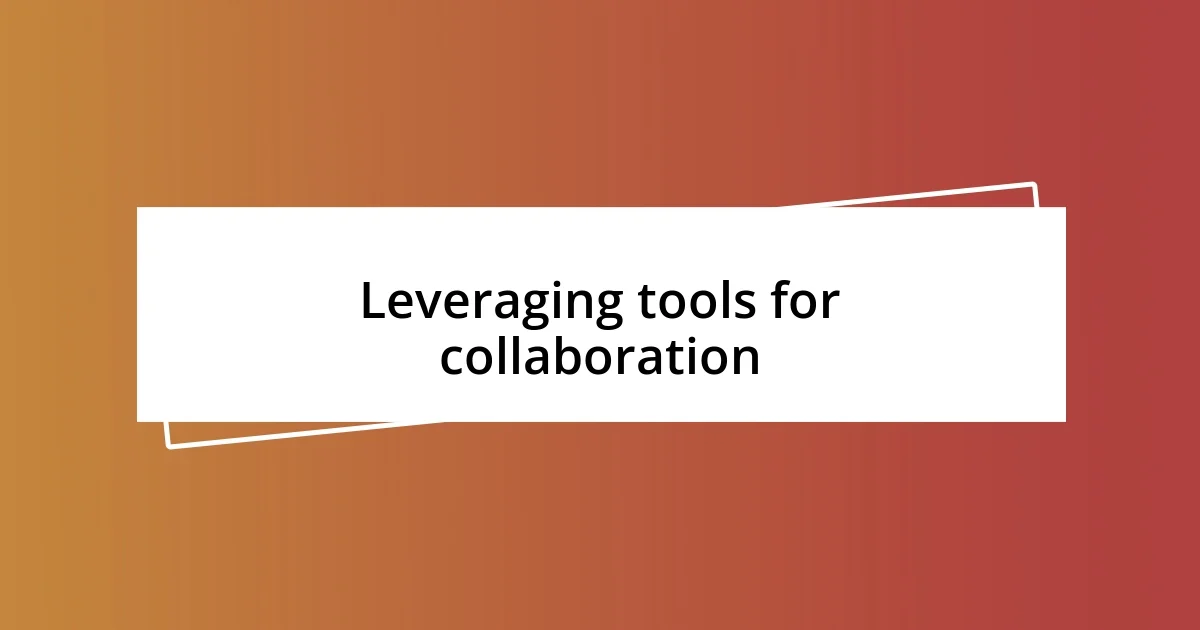
Leveraging tools for collaboration
Leveraging collaboration tools has significantly transformed how QA and Dev interact. I remember when we first implemented a shared project management tool. Suddenly, everyone could track progress in real-time. It felt refreshing to see the instant visibility into tasks and deadlines. I found it intriguing how this transparency fostered a sense of accountability. Have you ever experienced the shift in morale when everyone is on the same page? I can’t emphasize enough how this simple change uplifted our collaborative spirit, altering our engagement levels entirely.
We also began utilizing collaborative communication platforms. Initially, it was daunting—like jumping into the deep end all at once. But once we started using these tools, the dialogue opened up more than I could have imagined. I’ll never forget the excitement during a sprint review where developers and QA swiftly addressed issues through a chat feature. Conversations flowed effortlessly, and I could sense an eagerness to tackle challenges collaboratively. Does this not echo the ideal environment where problems are addressed collectively, rather than in isolation?
Moreover, adopting automated testing tools brought us closer than ever. I recall a specific instance where a developer highlighted a potential bug during a code review through our automated system. That quick feedback loop made everyone feel empowered to contribute to quality assurance. Watching the teams come together to resolve issues in real-time was exhilarating. It made me question, how often do we overlook the power of technology to enhance teamwork? In our case, it was a game-changer that deepened our collaboration and reinforced a shared goal of delivering quality products.
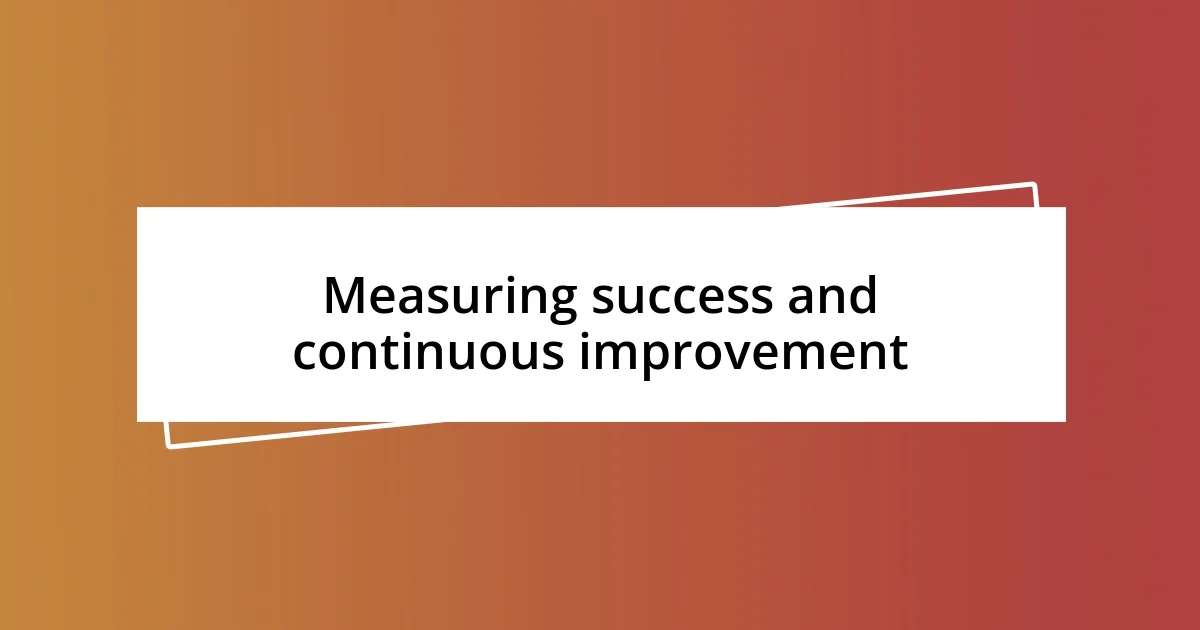
Measuring success and continuous improvement
Measuring success in collaboration between QA and Dev isn’t just about checking off boxes after completing a project; it’s about genuinely assessing how our new practices enhance our workflows. I remember the winds of change that followed our first retrospective meeting after implementing cross-team initiatives. Everyone contributed their insights, and there was an unmistakable shift in energy. We weren’t merely evaluating project outcomes; we were discussing the quality of our communication, the efficiency of our joint efforts, and the overall team morale. Isn’t it amazing how metrics can take on a life of their own when people feel invested?
Continuous improvement became a core part of our team culture, too. After our first few sprints, we adopted a “lessons learned” approach. I found that even small victories, like quicker bug identification, were celebrated. Each success was a stepping stone that encouraged open discussions about what practices we could refine next—a cycle of learning that felt invigorating. I often asked myself, how could something as simple as celebrating small wins create an environment ripe for innovation? Watching my colleagues embrace this mindset was truly inspiring.
On a more quantitative front, we actually tracked the speed and accuracy of our releases after implementing these collaboration strategies. I was thrilled when we saw a noticeable decrease in post-release bugs. It was like watching the fruits of our labor grow before my eyes! Reflecting on this, I thought, what if we measured collaboration not just by output, but also by team satisfaction and knowledge sharing? This dual approach allowed us to celebrate our progress as much as our achievements.












